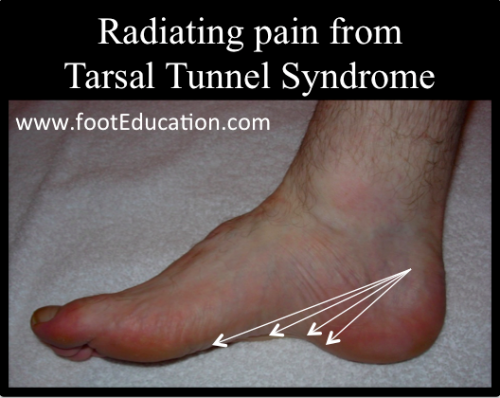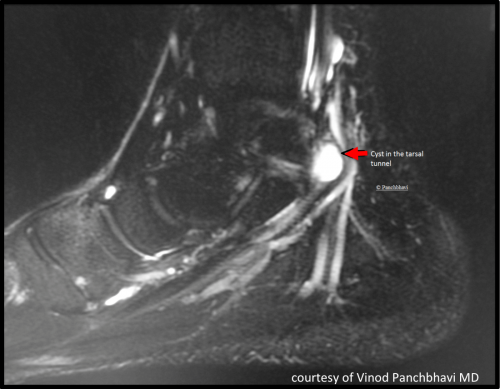Tarsal Tunnel Syndrome
Clinical Presentation
Patients with tarsal tunnel syndrome present with pain in the inside of the ankle or heel region that radiates into the sole of their foot (Figure 1). This pain can have a sharp, shooting, electrical, dull, or burning feeling and may be associated with numbness. The pain is often worse with activity and towards the evening. The pain occurs because the tibial nerve or its branches are compressed or stretched as they course under tight structures with limited space along the inner aspect of the ankle on their way to the sole of the foot.
This condition is commonly seen in conjunction with plantar fasciitis and acquired adult flatfoot deformity. In these conditions, the structures on the inside of the ankle (including the branches of the tibial nerve) are repetitively stretched (Figure 2). Excessive walking and increased body weight can exacerbate the patient’s symptoms.
Figure 1: Typical pain location

Figure 2: Repetitive Stretching of inner ankle region leading to tibial nerve irritation

In a small number of cases, there will be a physical mass, such as a bone spur or a ganglion that can press and injure the tibial nerve or its branches (Figure 3). Rarely the structures around the nerve are swollen or inflamed, leading to irritation of the nerve.
Physical Examination
On physical examination, patients will often have a flat foot type. Direct palpation over the inside of the ankle (posteromedial) will often reveal a localized area of pain with symptoms radiating into the sole of the foot. If direct pressure or tapping on the nerve reproduces patients symptoms, it is called a “Tinel’s sign.” Sensory examination of the foot may reveal some decreased sensation on the sole of the foot.
Nerve conduction studies will often show a decrease in conduction of electrical pulses over the course of the tibial nerve. It is also important to rule out nerve compression in the lower back which can cause similar symptoms.
Imaging Studies
Weight-bearing x-rays of the foot are typically used to assess for alignment or bony deformity. A CT scan or MRI is sometimes indicated to rule out a mass, which may be irritating the nerve (Figure 3).
Figure 3: MRI showing a fluid-filled ganglion that is compressing the tibial nerve

Treatment
The vast majority of patients with tarsal tunnel syndrome can (and should) be treated non-operatively. The primary approach to treating this condition is to attempt to decrease repetitive traction and decrease inflammation of the tibial nerve. In this regard, treatment is quite similar to treatment for acquired adult flatfoot deformity and plantar fasciitis.
Non-Operative Treatment
- Comfort shoes designed to disperse the force more evenly across the foot.
- A prefabricated orthotic with a supportive arch.
- Stretching exercises designed to stretch the calf muscle and thereby indirectly decrease the load through this area of the foot.
- Weight loss will often end up being a critically important component of non-operative treatment, as this will serve to decrease the repetitive forces through this area of the foot.
- Activity modification to limit the amount of standing and walking and thereby the amount of repetitive injury to this area is also an important component of non-operative management. Physical therapy to establish an exercise program characterized by appropriate fitness and stretching exercises, as well as some localized massage to help desensitize the area and perhaps breakdown scarring may be of some benefit.
- Corticosteroid injections may help to decrease the swelling around the nerve in the short and intermediate term. However, it is unclear what effect they have in the long term. In addition, it is possible to injure the nerve during the injection process.
- Non-steroidal anti-inflammatory medications.
Operative Treatment
Tarsal tunnel release has been proposed as a treatment for tarsal tunnel syndrome. Operative treatment should be undertaken with great caution!
Operative treatment typically involves releasing tight structures compressing the tibial nerve or removing masses compressing the nerve. Patients with masses in the tarsal tunnel may respond better to surgery.
Potential Surgical Complications
The main potential surgical complication is failure to eradicate symptoms, and in some cases, worsening symptoms. Post-operative scar tissue may lead to sensitivity and pain.
Other potential complications that are not specific to tarsal tunnel surgery include:
- Wound healing problems
- Infection
- Deep Venous Thrombosis (DVT)
- Pulmonary embolism
- Complex Regional Pain Syndrome (CRPS)
Previously edited by Vinod Panchbhavi MD
Edited November 19, 2017
mf/ 8.29.19